Greenwich Foot Tunnel: How Long Does It Take To Walk Through?
12 min readThe Greenwich Foot Tunnel is one of London’s hidden gems, an offbeat path that many use to get from one side of the River Thames to the other, yet countless...
The post Greenwich Foot Tunnel: How Long Does It Take To Walk Through? appeared first on Timeless Travel Steps.
The Greenwich Foot Tunnel is one of London’s hidden gems, an offbeat path that many use to get from one side of the River Thames to the other, yet countless more remain unaware of its existence. This marvel of Victorian engineering not only connects the bustling areas of Greenwich and the Isle of Dogs but also offers a fascinating journey through history beneath the river. One of the highlights of my recent visit to this area was to walk through the Greenwich Foot Tunnel and know exactly how long it takes to cover the distance.
The Greenwich Foot Tunnel remains a busy pedestrian route. It is estimated that over 1.2 million people use the tunnel annually, highlighting its ongoing relevance.
Let me take you through my experience and everything you need to know about this fascinating tunnel. In this post, I will guide you through the key aspects of this unique tunnel, from its length, how long it takes to walk the distance and opening times to its historical significance and practical tips for a safe and enjoyable passage. I shall also include some background information as to why it was built along with interesting facts for context which you may like to know.
Timeless Travel Steps is supported by our readers. If you purchase through an affiliate link on my site, at no cost to you, I may earn a commission from qualifying purchases. Please read our Disclosure for further information.
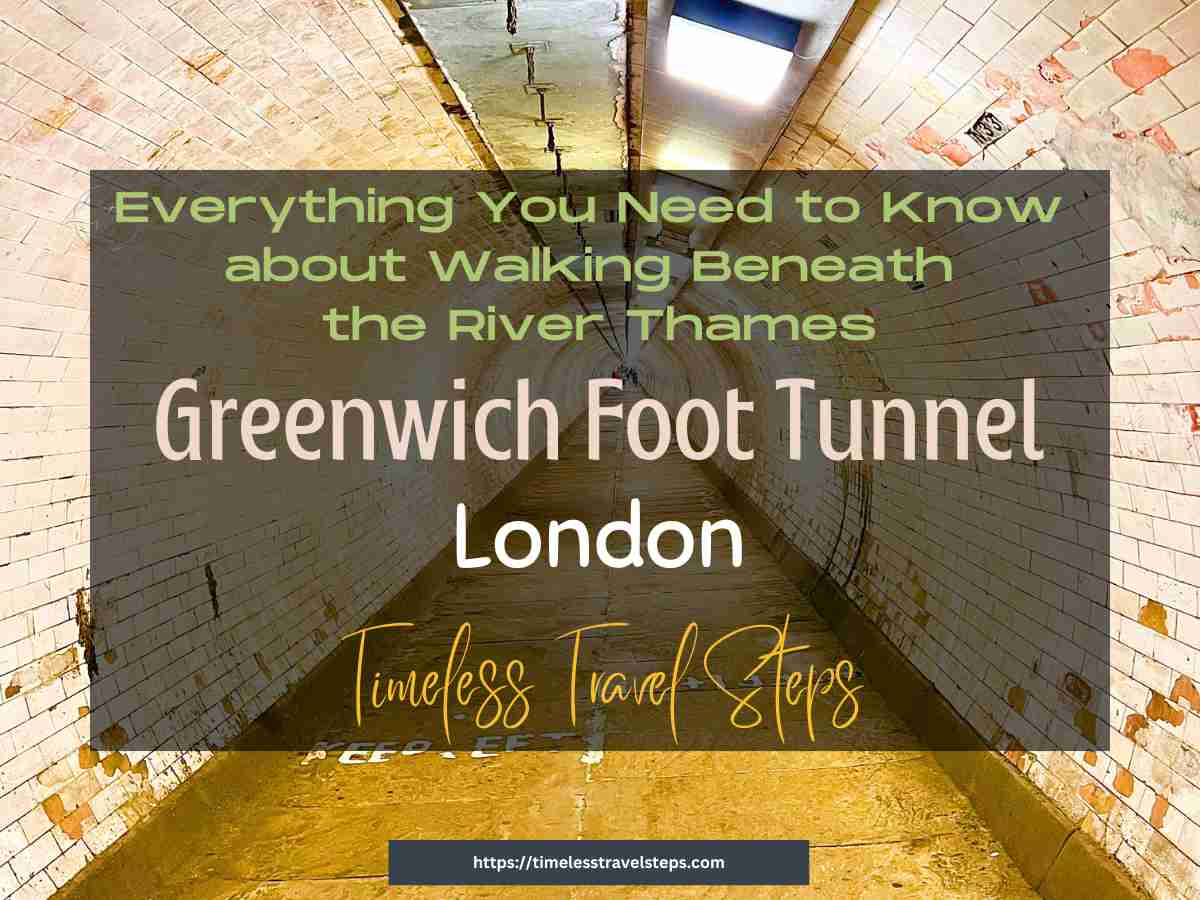
What You Need to Know about The Greenwich Foot Tunnel and How Long Does It Take To Walk Beneath the River Thames
Here’s everything you need to know about the Greenwich Foot Tunnel, how long it takes to walk through beneath the River Thames, and pro tips to help you plan your visit.
Greenwich Foot Tunnel Entrances
The Greenwich Foot Tunnel has two entrances/exits at both ends, each marked by distinctive domed buildings. On the south side, the entrance is located near the Cutty Sark in Greenwich, a historic area rich with maritime heritage. The north entrance is situated in Island Gardens on the Isle of Dogs, offering a peaceful park setting with stunning views of the Greenwich waterfront and the Canaletto View.
Both entrances are equipped with stairs and lifts, attracting all users of any abilities, from commuters to tourists exploring these off-the-trodden paths of London.
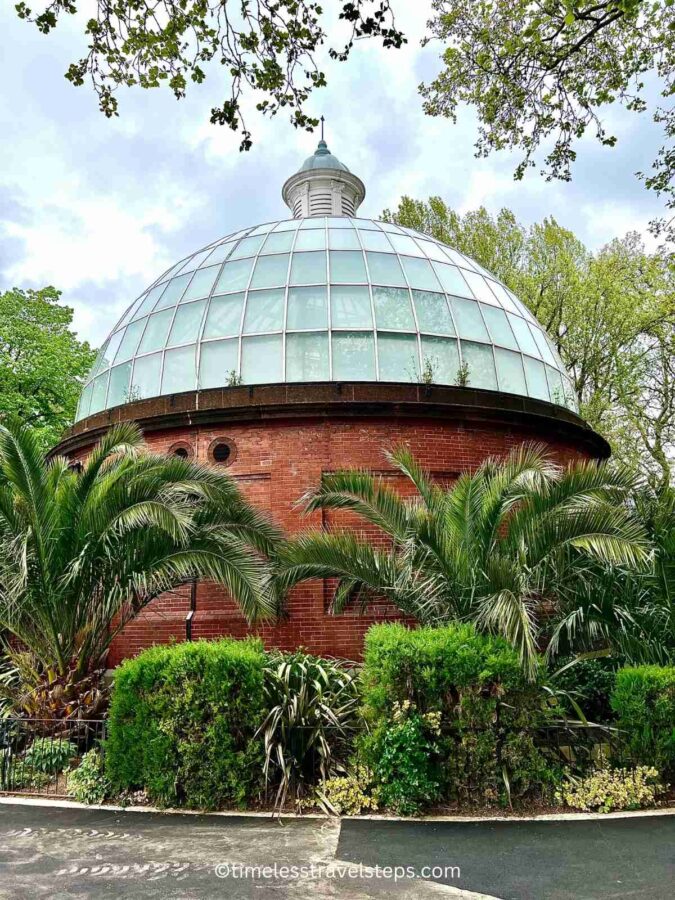
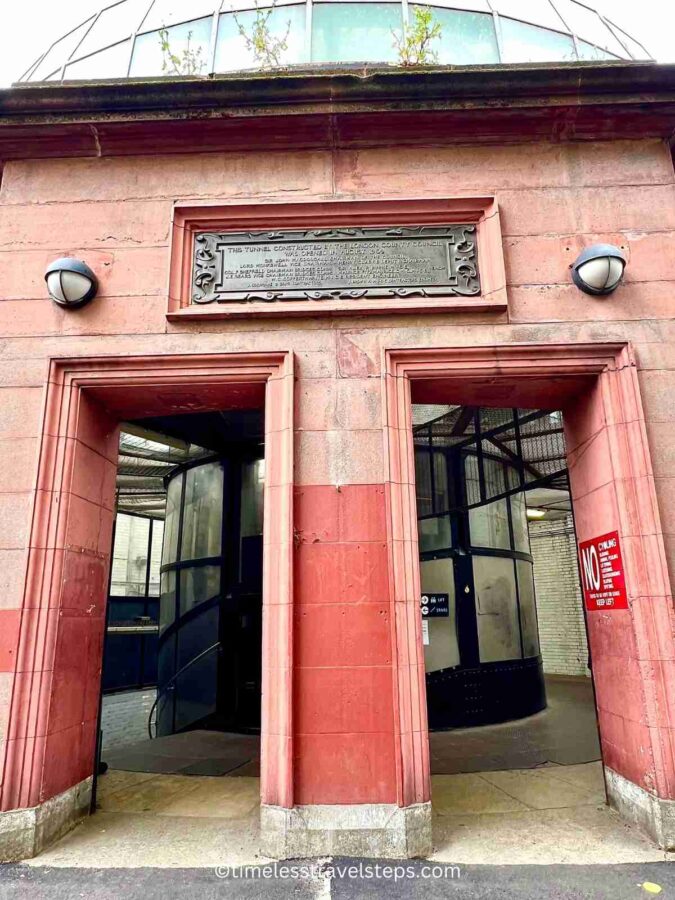
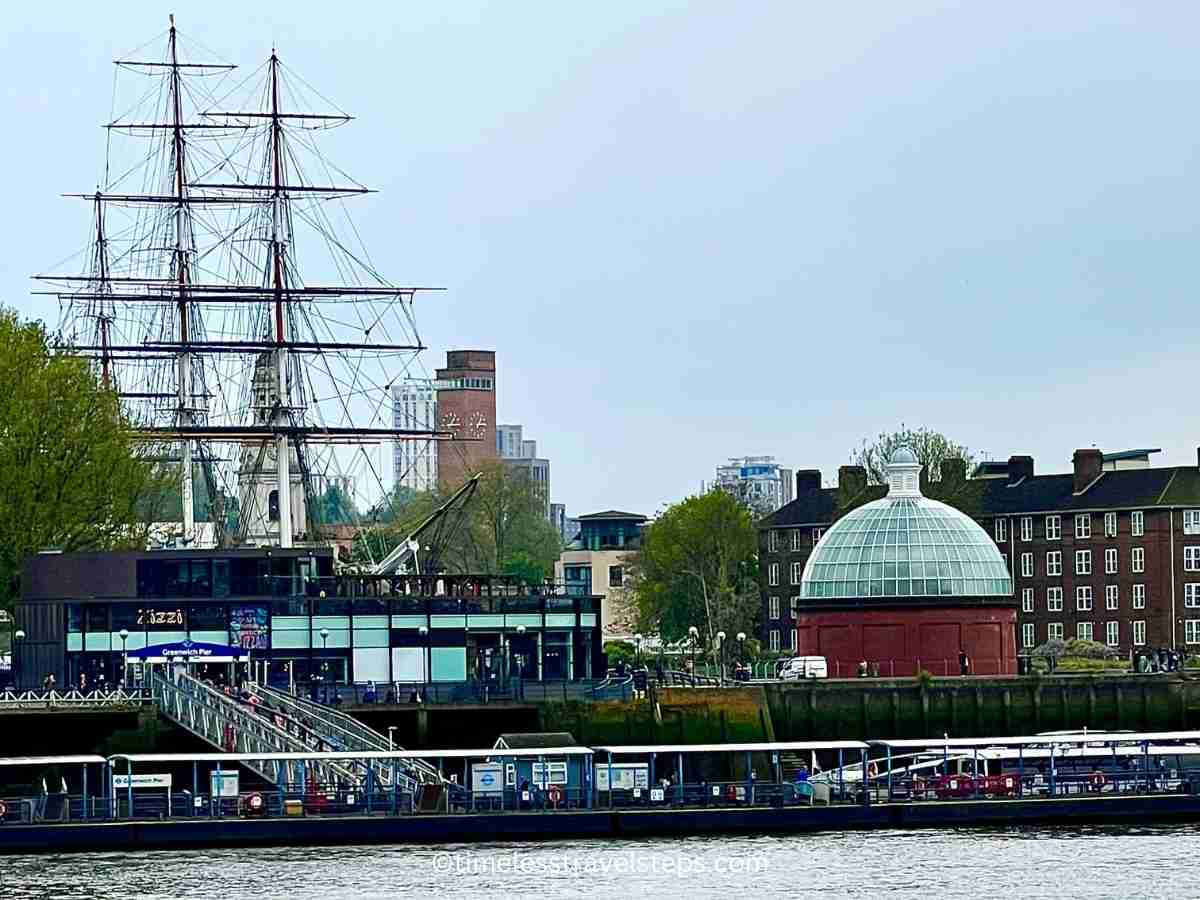
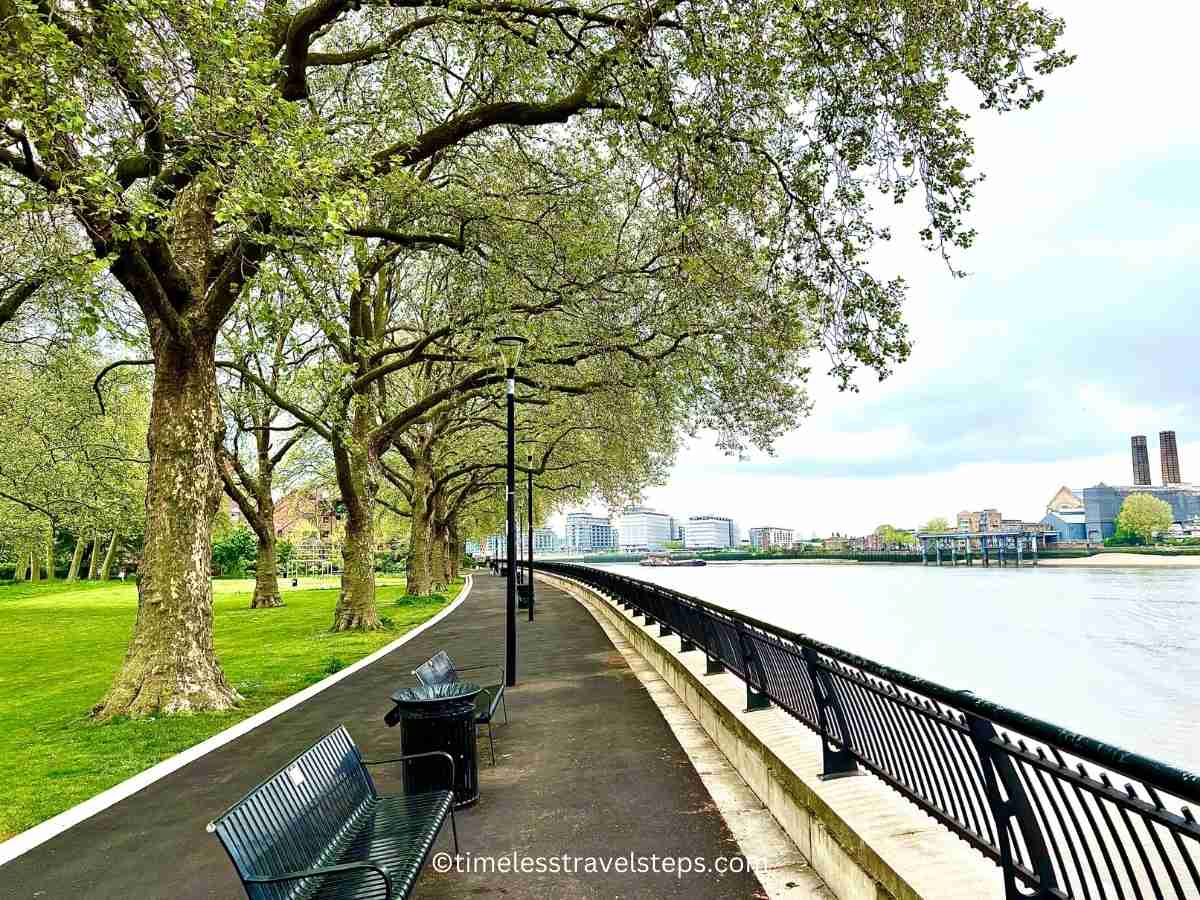
Greenwich Foot Tunnel Opening Times
The Greenwich Foot Tunnel is open 24 hours a day, providing an essential pedestrian link between Greenwich and the Isle of Dogs. The tunnel is equipped with lifts at both ends and are usually operational from early morning until late evening.
However, it’s worth noting that maintenance works can occasionally affect accessibility. When I visited, the lifts at the Cutty Sark end was out for maintenance, so it’s always a good idea to check the status of the foot tunnel on the official website for any temporary closures or restricted hours.
Greenwich Foot Tunnel Stairs and Lifts
You can navigate the Greenwich Foot Tunnel by using either stairs or lifts at both entrances, as these will invariably impact how long it takes you to complete the tunnel walk.
The original spiral staircases are still in use which adds a touch of historical charm. Some may find these rather steep, although I found it to be okay and sufficiently wide. I’ve navigated worse! At the Greenwich end, the stairs consist of 100 steps and 87 steps at the Isle of Dogs end.
If you are less inclined to tackle the stairs, the modern lifts provide a convenient alternative. The tunnel is equipped with lifts at both ends, making it accessible for those with mobility issues and for cyclists who prefer not to navigate the stairs.
These lifts are large enough to accommodate wheelchairs, pushchairs, and bicycles, ensuring accessibility for all.
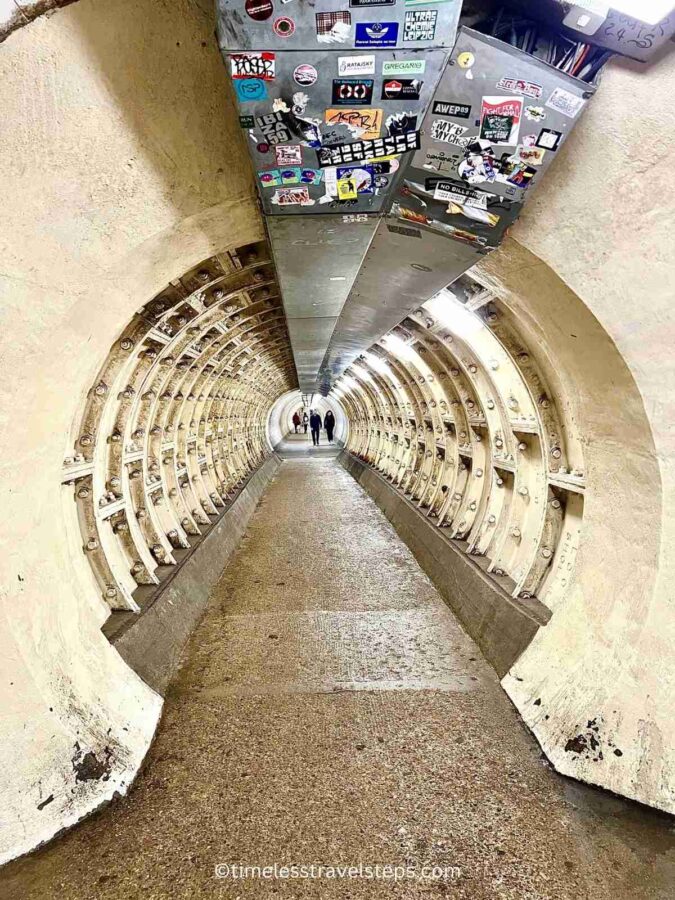
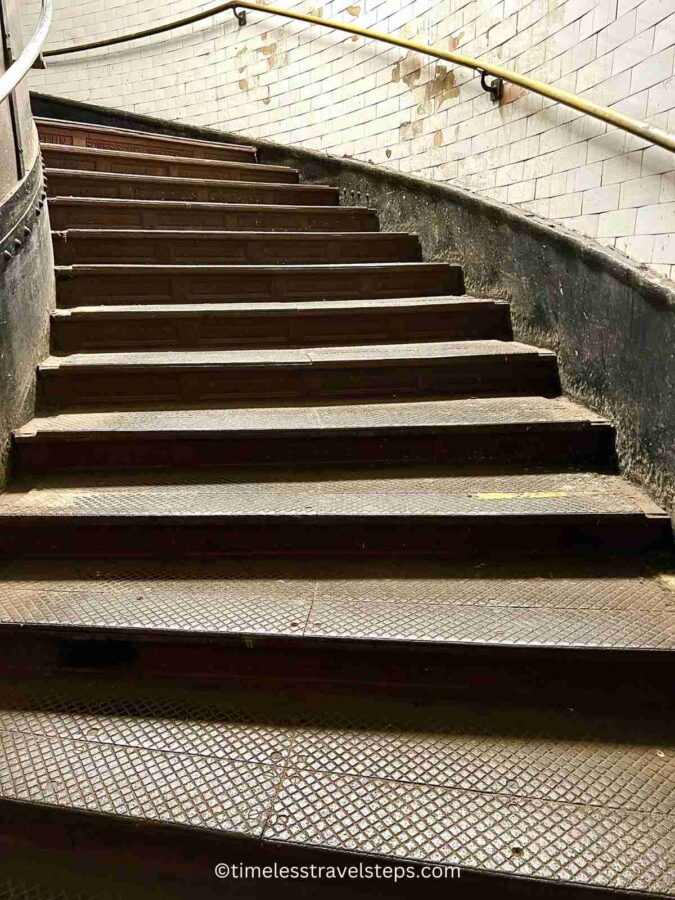
The Length of the Greenwich Foot Tunnel and How Long Does It take to Walk Through the Tunnel
The Greenwich Foot Tunnel stretches a total length of 370 meters (approximately 1,214 feet) beneath the River Thames. On average, it takes about 8 to 10 minutes to walk through, depending on your pace and whether you pause to appreciate the historic ambiance, and for photography. I suggest that you factor in additional time, perhaps 5 minutes, if you plan to use the stairs.
In total, for an average walker with an average walking speed, you’ll need 10 – 15 minutes to walk the entire length of the tunnel, from entrance to exit, with a couple of photo stops.
For cyclists, dismounting is required during peak times for the safety of other users. Therefore, as a cyclist, your journey can be just as long, or a bit quicker, if you’re fast paced. If you cycle through, it shouldn’t take more than 5 minutes.
This length makes it a convenient and swift passage, especially compared to the detours required by other routes on ground across the river.
Walking through the Greenwich Foot Tunnel
Walking through a tunnel beneath a river might seem intimidating to some, and those prone to claustrophobia might feel uneasy. However, I didn’t feel that way and found the experience to be quite manageable. The tunnel is well-lit and maintained, with a spacious enough walkway for two-way pedestrian traffic.
The metal casing at the beginning of the tunnel on the Island Gardens end may invoke a feeling of confinement, but it extends only for a few metres. It was installed to repair the damage sustained during the Blitz. It is reassuring as you can actually see the end of the tunnel, once you go past the metal casing bit.
While the thought of being directly under the River Thames can be daunting, the journey through the tunnel felt safe and straightforward. There are people constantly using the tunnel, mostly alone, in two or in small families, providing additional reassurance.
If you are apprehensive about the enclosed space, I can assure you that it is not overly confined. Walking through the tunnel felt quite comfortable and did not take long.
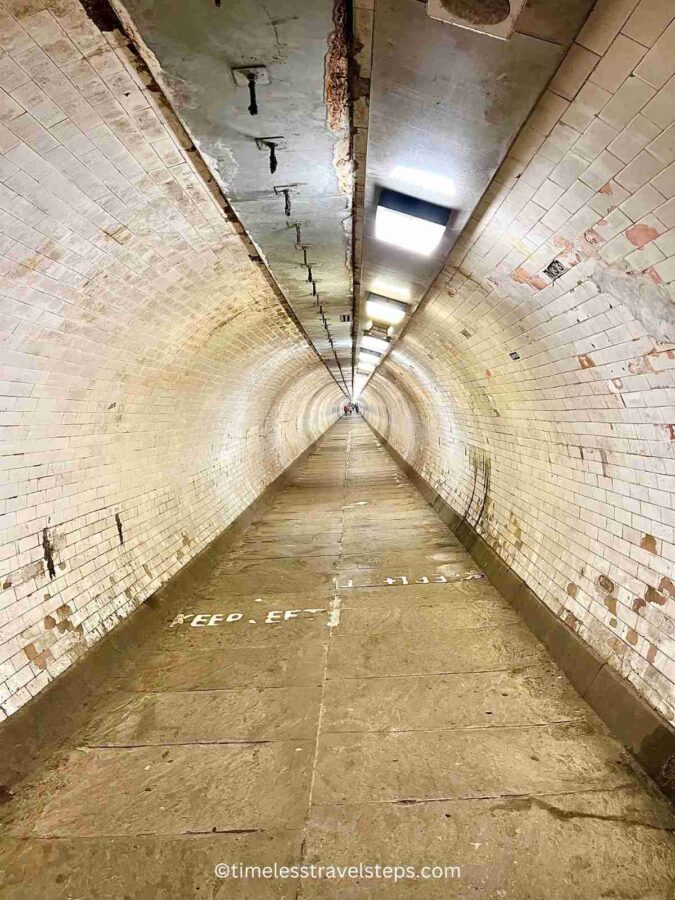
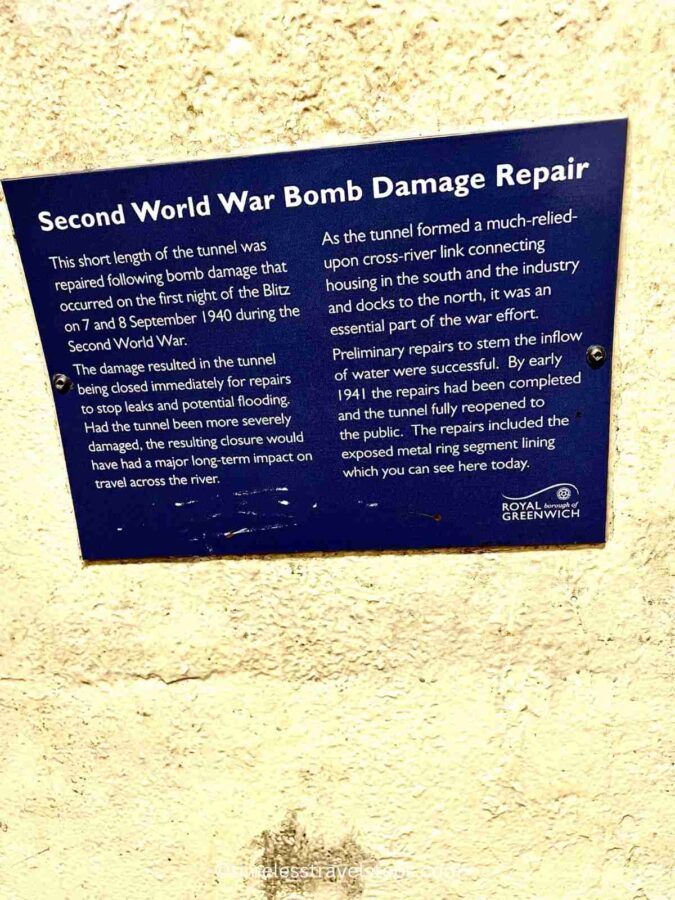
Greenwich Foot Tunnel Depth
At its deepest point, the Greenwich Foot Tunnel is approximately 15 meters (about 50 feet) below the surface of the River Thames. This impressive depth is a testament to the engineering prowess of the early 20th century, when the tunnel was constructed.
Walking through the tunnel, you’ll appreciate the marvel of passing beneath one of the world’s most iconic rivers, a hidden journey that most London visitors overlook.
Greenwich Foot Tunnel Cycling/Bike
Cycling through the Greenwich Foot Tunnel is permitted, but with certain restrictions to ensure safety. As cyclists, you are required to dismount and walk your bikes through the tunnel during peak times or when it’s busy with pedestrians.
The tunnel’s lifts are spacious enough to easily accommodate bicycles, and pedestrians, providing an easy way to transport bikes up and down from the tunnel entrances.
Is the Greenwich Foot Tunnel Safe?
One of the most frequently asked questions about the Greenwich Foot Tunnel is whether it is safe. I think it is fair to say that safety within the Greenwich Foot Tunnel has always been a priority, given that it is an essential route for commuters who use it daily, avoiding the roads and trains.
The tunnel is well-lit and monitored by CCTV cameras throughout its length. Regular maintenance ensures the structural integrity and cleanliness of the passage. While incidents are rare, the presence of emergency call points and clear signage contributes to a sense of security while using the tunnel. As with any public space, it’s advisable to take safety precautions and remain aware of your surroundings, particularly during quieter times.
How to Get to the Greenwich Foot Tunnel: Nearest Stations to Greenwich Foot Tunnel
The nearest station to the Greenwich Foot Tunnel on the south side is the Cutty Sark DLR Station, just a short walk from the tunnel entrance. This station provides excellent connectivity to other parts of London, making it easy for you to access the tunnel.
On the north side, the nearest station is Island Gardens DLR Station, conveniently located near the tunnel’s entrance in Island Gardens Park.
Both stations offer regular services, ensuring that the tunnel is easily reachable for both locals and tourists.
Additionally, here are more ways to reach the foot tunnel:
Greenwich Railway Station: Located on Greenwich High Road, this station is serviced by Southeastern trains and is about a 12-minute walk from the tunnel entrance near Cutty Sark. It offers convenient connections to London Bridge, Cannon Street, and other parts of London.
Maze Hill Railway Station: Situated slightly to the east of Greenwich Park, Maze Hill is another Southeastern train station that provides access to the foot tunnel. It’s about a 15-20 minute walk from the station to the tunnel.
Greenwich Pier: For a scenic route, you can take a Thames Clipper riverboat service to Greenwich Pier. The pier is a pleasant 5-minute walk from the tunnel entrance, offering a picturesque approach along the riverside.
Buses: Several bus routes serve the Greenwich area, including routes 129, 177, 180, 188, 199, and 386. These buses stop near key points in Greenwich, making it easy to reach the foot tunnel from various parts of London.
Walking and Cycling: If you’re already in the area, walking or cycling to the foot tunnel is a great option. Greenwich is a pedestrian-friendly area with many pathways and cycle routes leading to the tunnel entrance near Cutty Sark or Island Gardens.
These alternatives provide a variety of convenient ways to access the Greenwich Foot Tunnel. Choose the best route based on your starting location and preferred mode of transport.
PRO TIP: If you want to get to Greenwich swiftly, I suggest that you take the DLR (Docklands Light Railway). The DLR departs from Central London, Bank Station and the journey is roughly 20 minutes to Cutty Sark Station.
Beyond the Greenwich Foot Tunnel
When exploring the Greenwich Foot Tunnel, take the opportunity to discover the rich history and vibrant culture of Greenwich itself. This area is highly touristy and home to a wealth of attractions that cater to history buffs, art lovers, and food enthusiasts alike.
Start your journey at the Royal Observatory, perched atop Greenwich Park. Here, you can stand on the Prime Meridian, where the Eastern and Western Hemispheres meet, and explore fascinating exhibits on astronomy and timekeeping. The observatory also offers stunning panoramic views of the London skyline.
For those interested in naval history, the Cutty Sark is an unmissable attraction. This historic British clipper ship, now a museum, offers insights into the golden age of sail and maritime trade.
PRO TIP: To make your visit more economical, consider purchasing a combined ticket that includes entry to both the Royal Observatory and the Cutty Sark, allowing you to experience two of Greenwich’s premier attractions at a discounted rate.
Next, visit the National Maritime Museum, part of the Royal Museums Greenwich, which houses an impressive collection of maritime artifacts, model ships, and historic paintings. Just a short walk away, you’ll find the Queen’s House, a masterpiece of classical architecture that showcases exquisite art, including the renowned Tulip Stairs.
Absolutely not to be missed is the Painted Hall at the Old Royal Naval College, often referred to as the “Sistine Chapel of the UK.” Its magnificent Baroque interiors and dramatic ceiling paintings provide a breathtaking experience that rivals its namesake in Rome.
After a day of exploration, Greenwich offers a variety of dining options to satisfy your hunger. Enjoy a meal at Goddards at Greenwich, a family-run pie and mash shop that has been serving traditional British fare since 1890. For a more contemporary dining experience, visit The Greenwich Tavern, which offers a range of modern British dishes in a cozy pub setting. For a relaxing break, head to The Old Brewery, located within the grounds of the Old Royal Naval College, where you can enjoy craft beers brewed on-site and a selection of hearty pub dishes.
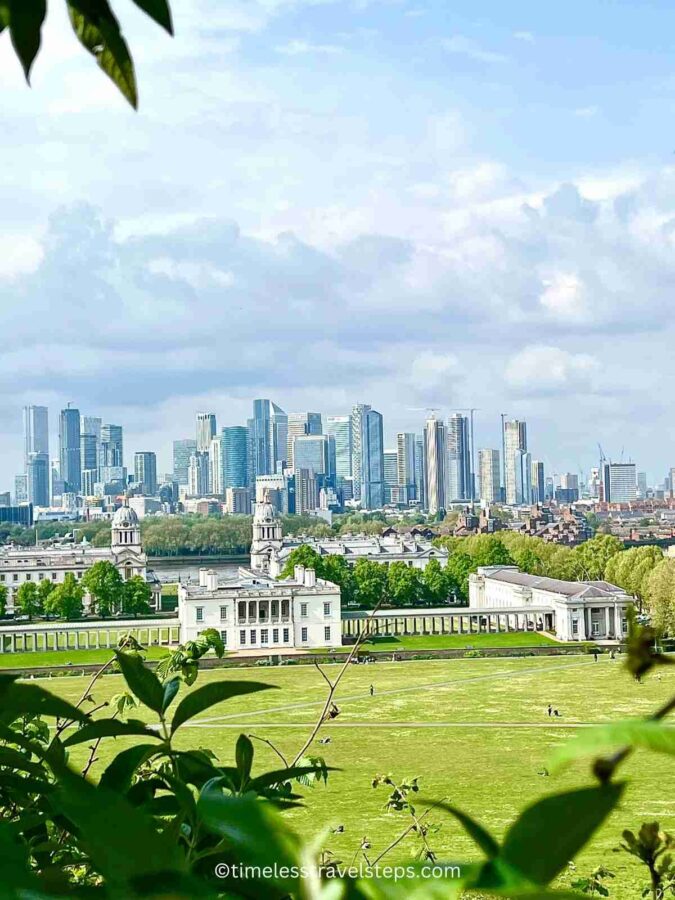
Admission Tickets for Attractions in Greenwich, London
Read REVIEWS + BOOK Ticket/s to the Painted Hall and Tour of the Old Royal Naval College, Greenwich.
BOOK A stand-alone Entry Ticket to the Royal Observatory Greenwich ONLY.
BOOK a stand-alone Entry Ticket to the Cutty Sark, Greenwich ONLY.
BOOK the Money Saver; Royal Museums Greenwich Day Pass for Admission to The Royal Observatory and the Cutty Sark.
History Overview: When and Why was the Greenwich Foot Tunnel Built?
Now that I have covered the relevant information about the foot tunnel and the various activities you can enjoy in Greenwich town itself, I thought you might like to know a little about the history of the tunnel. Here’s what I know from my research prior to visiting the Greenwich Foot Tunnel about when and why it was built.
The Greenwich Foot Tunnel is a product of Victorian-era engineering, although it was completed just after the turn of the 20th century.
Designed by Sir Alexander Binnie, work began in 1899 and the tunnel was completed in 1902, opening to the public on August 4, 1902.
The primary reason for building the Greenwich Foot Tunnel was to provide a reliable, all-weather crossing beneath the River Thames, specifically for the workers in the densely populated areas of the south (Greenwich) who had to travel to the industrial docks in the north (Isle of Dogs). Before the tunnel was born, these workers relied on an inconsistent and often unreliable ferry service.
Its construction reflected the Victorian era’s commitment to improving urban infrastructure and public amenities. The foot tunnel allowed for safer travel, taking not too long to walk from one bank of the river to the other, hence a more efficient commute. The tunnel facilitated economic growth and enhanced the daily lives of thousands of workers in the Thames area.
Over the years, there has been several upgrades to the Greenwich Foot Tunnel, including significant refurbishments in 2010-2011, which included the installation of new lifts, improved lighting, and structural repairs. These improvements were crucial in maintaining the tunnel’s usability and safety for modern-day pedestrians and cyclists.

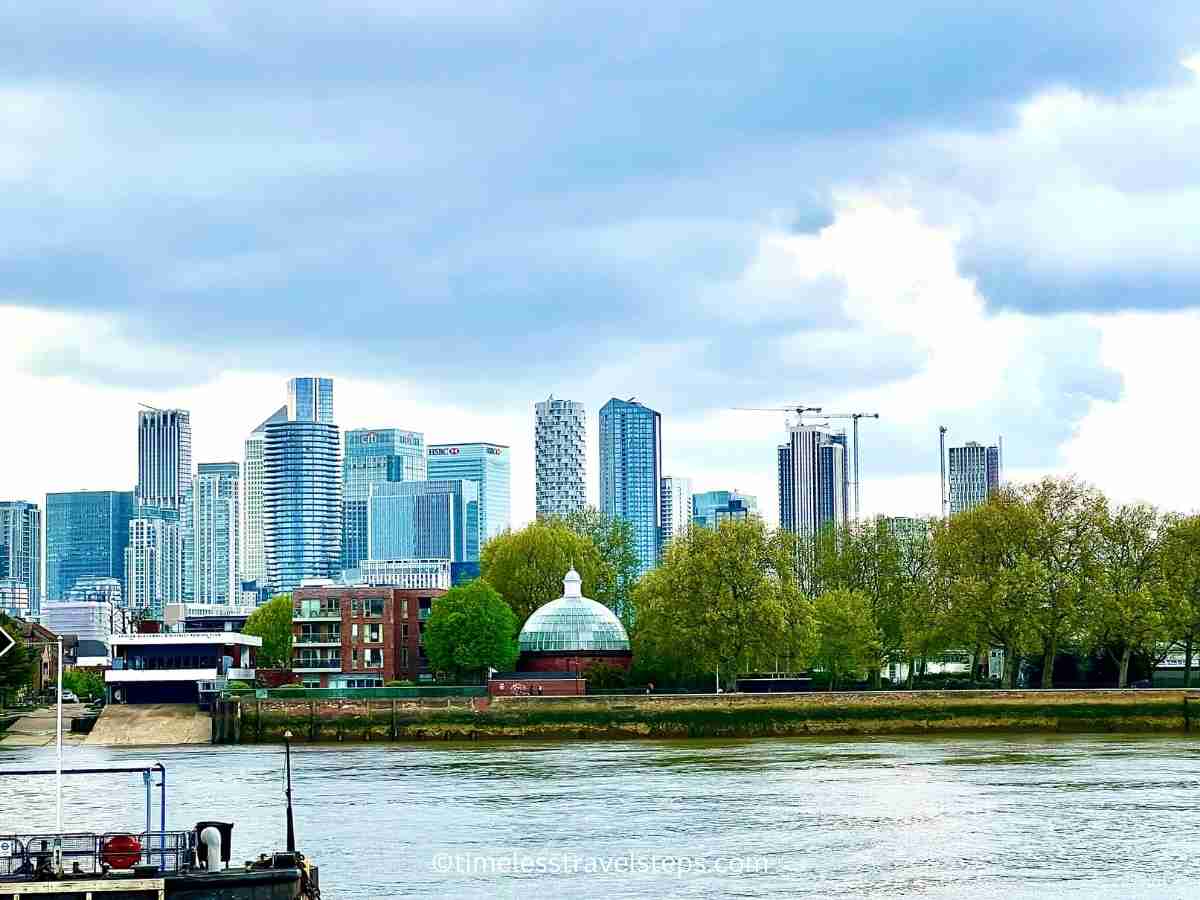
Above, you see the two distinct domed entrances, one located near the Cutty Sark (left), and the other at Island Gardens (right). These uniquely interesting structures are London’s Grade II listed buildings.
Interesting Facts about the Greenwich Foot Tunnel
The Greenwich Foot Tunnel boasts a number of fascinating facts. Here are a few I found out which you may like to know:
World War II
During World War II, the Greenwich Foot Tunnel sustained damage from bombing raids, necessitating swift repairs to maintain its crucial role. Post-war improvements included the installation of metal panels to replace the damaged sections, enhancing the tunnel’s structural integrity. These renovations ensured the tunnel remained a vital pedestrian link between Greenwich and the Isle of Dogs, and continues to do so to this day.
Architectural Ingenuity of the Tunnel’s Domed Entrances
At first sight, the tunnel’s domes look rather bland, constructed with reddish-brown bricks. Interestingly, the tunnel’s domed entrances are Grade II listed buildings, a designation that recognizes their architectural and historical significance. These distinctive structures, with their elegant glass and iron domes, are fine examples of early 20th-century design and engineering, standing as iconic landmarks of England.
Engineering Feat
The tunnel was constructed using the “Greathead Shield” technique, an innovative method at the time, named after its inventor, James Henry Greathead. This technique allowed workers to excavate and line the tunnel simultaneously, significantly speeding up the construction process and ensuring safety.
Sustainability
By encouraging walking and cycling, the Greenwich Foot Tunnel promotes sustainable transportation methods, reducing the reliance on motor vehicles and contributing to lower carbon emissions in the area.
Unique Acoustics
The tunnel’s curved structure and enclosed space create unique acoustic properties. Sounds often echo in unusual ways, adding to the tunnel’s distinctive ambiance. When you are walking through the tunnel, try saying ‘hello’ and hear the subtle echoes, it really is something…
I hope you’ve enjoyed reading about these facts, unique to the Greenwich Foot Tunnel, to enhance your visit.
in sum…
There is no doubt that the Greenwich Foot Tunnel offers a unique and practical route between Greenwich and the Isle of Dogs. Additionally, the tunnel offers an insight to London’s rich maritime history, and the Victorian engineering ingenuity. For me, it offers some thoughts about how people lived in those days, after a long day at the docks, maximising their time, and saving money by walking across instead of ferry rides. I hope this guide has provided you with valuable insights and encourages you to explore this lesser-known yet fascinating part of London.
Happy and Safe Travels Always, Wherever Travel Takes You, xx
For more travel insights and tips, consider following Georgina on Instagram and Facebook. Don’t miss out on her latest adventures and expert advice. Subscribe to stay updated and join a community of fellow travel enthusiasts eager to explore the world through Georgina’s eyes.



